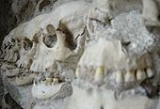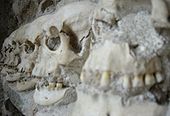
Skull Tower
Encyclopedia

First Serbian Uprising
The First Serbian Uprising was the first stage of the Serbian Revolution , the successful wars of independence that lasted for 9 years and approximately 9 months , during which Serbia perceived itself as an independent state for the first time after more than three centuries of Ottoman rule and...
. It is situated in Niš
Niš
Niš is the largest city of southern Serbia and third-largest city in Serbia . According to the data from 2011, the city of Niš has a population of 177,972 inhabitants, while the city municipality has a population of 257,867. The city covers an area of about 597 km2, including the urban area,...
, on the old Constantinople
Constantinople
Constantinople was the capital of the Roman, Eastern Roman, Byzantine, Latin, and Ottoman Empires. Throughout most of the Middle Ages, Constantinople was Europe's largest and wealthiest city.-Names:...
Road leading to Sofia
Sofia
Sofia is the capital and largest city of Bulgaria and the 12th largest city in the European Union with a population of 1.27 million people. It is located in western Bulgaria, at the foot of Mount Vitosha and approximately at the centre of the Balkan Peninsula.Prehistoric settlements were excavated...
. The monument was built using the skulls of the Serbs killed by order of Ottoman Sultan
Ottoman Dynasty
The Ottoman Dynasty ruled the Ottoman Empire from 1299 to 1922, beginning with Osman I , though the dynasty was not proclaimed until Orhan Bey declared himself sultan...
Mahmud II
Mahmud II
Mahmud II was the 30th Sultan of the Ottoman Empire from 1808 until his death in 1839. He was born in the Topkapi Palace, Istanbul, the son of Sultan Abdulhamid I...
during the 1809 Battle of Čegar
Battle of Cegar
The Battle of Čegar was an engagement in the First Serbian Uprising against the Ottoman Empire.On May 31, 1809, the most prominent trench on Čegar Hill, under the command of Stevan Sinđelić, was attacked by the Ottoman troops. The battle lasted the whole day. As Milovan Kukić witnessed, the Ottoman...
.
History
On May 31, 1809 on Čegar Hill a few kilometers northeast of Niš, SerbianSerbs
The Serbs are a South Slavic ethnic group of the Balkans and southern Central Europe. Serbs are located mainly in Serbia, Montenegro and Bosnia and Herzegovina, and form a sizable minority in Croatia, the Republic of Macedonia and Slovenia. Likewise, Serbs are an officially recognized minority in...
insurrectionists suffered their greatest defeat in the First Serbian Uprising
First Serbian Uprising
The First Serbian Uprising was the first stage of the Serbian Revolution , the successful wars of independence that lasted for 9 years and approximately 9 months , during which Serbia perceived itself as an independent state for the first time after more than three centuries of Ottoman rule and...
against the Ottoman Empire
Ottoman Empire
The Ottoman EmpireIt was usually referred to as the "Ottoman Empire", the "Turkish Empire", the "Ottoman Caliphate" or more commonly "Turkey" by its contemporaries...
(1804-1813). The insurrectionists' advance towards Niš was stopped here and, when the far stronger Turkish forces attacked, the battle was ended by the Serbian commander Stevan Sinđelić, who sacrificially fired at his gunpowder depot in order to avoid surrendering to the Turks, killing himself, the rest of his men, and the advancing Turks.
After the retreat of the Serbian rebel army, the Turkish commander of Niš, Hursid Pasha
Hursid Pasha
Hurşid Ahmed Pasha was an Ottoman General and Grand Vizier during the early 19th century. He was of Georgian descent.- Early life :...
, ordered that the heads of the killed Serbs were to be mounted on a tower to serve as a warning to whoever opposed the Ottoman Empire. In all, 952 skulls were included, with the skull of Sinđelić placed at the top. The scalps from the skulls were stuffed with cotton and sent to Constantinople
Constantinople
Constantinople was the capital of the Roman, Eastern Roman, Byzantine, Latin, and Ottoman Empires. Throughout most of the Middle Ages, Constantinople was Europe's largest and wealthiest city.-Names:...
(modern Istanbul
Istanbul
Istanbul , historically known as Byzantium and Constantinople , is the largest city of Turkey. Istanbul metropolitan province had 13.26 million people living in it as of December, 2010, which is 18% of Turkey's population and the 3rd largest metropolitan area in Europe after London and...
) as proof for Sultan
Ottoman Dynasty
The Ottoman Dynasty ruled the Ottoman Empire from 1299 to 1922, beginning with Osman I , though the dynasty was not proclaimed until Orhan Bey declared himself sultan...
Mahmud II
Mahmud II
Mahmud II was the 30th Sultan of the Ottoman Empire from 1808 until his death in 1839. He was born in the Topkapi Palace, Istanbul, the son of Sultan Abdulhamid I...
.
The tower stood in the open air until the liberation of Niš in 1878. By that time, much of the tower had deteriorated from weather conditions or from the removal of skulls for burial by relatives of killed rebels. In 1892, with donations gathered from all over Serbia, a chapel
Chapel
A chapel is a building used by Christians as a place of fellowship and worship. It may be part of a larger structure or complex, such as a church, college, hospital, palace, prison or funeral home, located on board a military or commercial ship, or it may be an entirely free-standing building,...
designed by the Belgrade
Belgrade
Belgrade is the capital and largest city of Serbia. It is located at the confluence of the Sava and Danube rivers, where the Pannonian Plain meets the Balkans. According to official results of Census 2011, the city has a population of 1,639,121. It is one of the 15 largest cities in Europe...
architect Dimitrije T. Leko
Dimitrije T. Leko
Dimitrije T. Leko was a renowned Serbian architect and urbanist. He has spent most of his life outside Serbia – he had finished high school in Winterthur, before studying architecture at the universities in Zürich, Aachen and Munich...
was built to enclose what was left of the tower. Today, only 58 skulls remain, including that of Sinđelić.
In front of the chapel stands the monument to Sinđelić, and a small relief depicting the battle, both from 1937. The monument commemorating the battle in the form of a guard tower was built in 1927 on Čegar Hill by Julian Djupon. The lower part is made out of stone from the Niš fortress
Niš Fortress
Niš Fortress is a fortress in the city of Niš, Serbia. It is a complex and very important cultural and historical monument. It rises on the right bank of the Nišava River, and is over two millennia old....
.
Skull Tower was declared Monument of Culture of Exceptional Importance
Monuments of Culture of Exceptional Importance (Serbia)
Cultural Monuments of Exceptional Importance are the monuments in the Republic of Serbia that have the highest level of the State protection, and some of them are part of the UNESCO World Heritage Sites....
in 1979, and it is protected by Republic of Serbia.
In popular culture
The cover of the 1985 album IstinaIstina
Istina is the sixth studio album released by Serbian and former Yugoslav rock band Riblja Čorba....
released by Serbian hard rock
Hard rock
Hard rock is a loosely defined genre of rock music which has its earliest roots in mid-1960s garage rock, blues rock and psychedelic rock...
band Riblja Čorba
Riblja Corba
Riblja Čorba is a Serbian and former Yugoslav rock band. Their presence on the scene has lasted from 1978 to today. They reached their peak of popularity in the 1980s, but it has declined in the 1990s, partly due to controversial political attitudes of the band's leader Bora Đorđević...
featured the band members' faces among the skulls on a Skull Tower wall.
Quotes
- Alphonse de LamartineAlphonse de LamartineAlphonse Marie Louis de Prat de Lamartine was a French writer, poet and politician who was instrumental in the foundation of the Second Republic.-Career:...
, Journey to the East, 1833
See also
- Monument of Culture of Exceptional ImportanceMonuments of Culture of Exceptional Importance (Serbia)Cultural Monuments of Exceptional Importance are the monuments in the Republic of Serbia that have the highest level of the State protection, and some of them are part of the UNESCO World Heritage Sites....
- Tourism in SerbiaTourism in SerbiaSerbia stretches across two geographic and cultural regions of Europe: Central Europe and Southeast Europe. This boundary splits Serbia roughly in a ratio of 1:2 alongside the Danube and Sava rivers. The northern parts of the country are Central-European lowlands while the southern and central...

